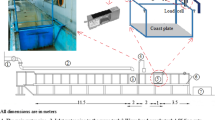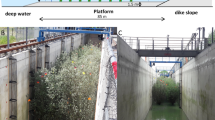Abstract
The tsunami mitigation strategies are shifting from single to multiple defense systems in recent times. In this study, the mitigation effects of continuous and discontinuous emergent coastal forest were investigated experimentally focused mainly on energy reduction of the inundating tsunami current under subcritical flow conditions. To improve the effectiveness of the coastal forest, a layer of short submerged trees with the varying condition of porosity (Pr = 98%, 95%, 91%, and 79%) was coupled/incorporated and tested with the tall emergent trees. The results revealed that the forest in discontinuous placement effectively produced resistance to the flow by notably increasing the backwater rise in the upstream and reducing the energy of the tsunami current in the downstream region, rather than a continuous forest belt. The incorporation of short submerged tree layer within an emergent tall tree forest further increased the flow resistance by causing a large water level difference between the upstream and downstream regions of the forest, which consequently resulted in a significant amount of energy loss i.e. 30–50% higher, in comparison to that of single layered emergent tree configuration. Moreover, the critical zone of high shear stress and large turbulence hydraulic jump formation zone was observed to significantly move in the further downstream region for discontinuous and layered tree forest configurations, that could possibly save the direct collision of water with the ground just behind the forest. The outcomes predicted by the statistical analysis approach also showed a strong inverse correlation between the energy dissipation of flow and forest porosity.









Similar content being viewed by others
References
Adam AM, Ruff JF, AlQaser G, Abt SR (1993) Characteristics of B-jump with different toe locations. J Hydraul Eng 119:938–948
Ali A, Tanaka N (2020) Experimental study of scouring downstream of coastal vegetation in an inundating tsunami current. Landsc Ecol Eng. https://doi.org/10.1007/s11355-020-00420-z
Anjum N, Tanaka N (2020) Changes in the flow structure and energy loss of a tsunami current through forest with a gap. In: Proceedings of the 22nd IAHR-APD congress, Sapporo, Japan, vol 6-5-1
Anjum N, Tanaka N (2019) Numerical investigation of velocity distribution of turbulent flow through vertically double-layered vegetation. Water Sci Eng 12(4):319–329
Chanson H (1993) Characteristics of undular hydraulic jumps (no. CE146). Department of Civil Engineering, The University of Queensland, St Lucia
Chanson H (2009) Current knowledge in hydraulic jumps and related phenomena. Eur J Mech B Fluids 28:191–210
Chanson H, Paintal A (2003) Hydraulics of stepped chutes and spillways. Appl Mech Rev 56:B10
Chow VT (1959) Open channel hydraulics. McGraw-Hill Publishing Co., New York
De Costa R, Tanaka N (2020) Inland forest as a trapping function against tsunami-borne large broken or washed out trees. Landsc Ecol Eng 16:97–112. https://doi.org/10.1007/s11355-020-00408-9
Dengler L, Preuss J (2003) Mitigation lessons from the July 17, 1998 Papua New Guinea tsunami. Pure Appl Geophys 160:2001–2031
Fritz HM, Borrero JC, Synolakis CE, Yoo J (2006) 2004 Indian Ocean tsunami flow velocity measurements from survivor videos. Geophys Res Lett. https://doi.org/10.1029/2006GL026784
Harada K, Imamura F (2005) Effects of coastal forest on tsunami hazard mitigation—a preliminary investigation. In: Satake K (ed) Tsunamis. Advances in natural and technological hazards research, vol 23. Springer, Dordrecht. https://doi.org/10.1007/1-4020-3331-1_17
Igarashi Y, Tanaka N (2016) Multiple defense for tsunami inundation by two embankment system and prevention of oscillation by trees on embankment. In: Proceedings of the 20th congress of IAHR APD congress, Colombo, Sri Lanka, 28–31 August
Igarashi Y, Tanaka N (2018) Effectiveness of a compound defense system of sea embankment and coastal forest against a tsunami. Ocean Eng 151:246–256
Iimura K, Tanaka N (2012) Numerical simulation estimating effects of tree density distribution in coastal forest on tsunami mitigation. Ocean Eng 54:223–232
Irish JL, Weiss R, Yang Y, Song YK, Zainali A, Marivela-Colmenarejo R (2014) Laboratory experiments of tsunami runup and withdrawal in patchy coastal forest on a steep beach. Nat Hazards 74:1933
Ishigaki A, Higashi H, Sakamoto S, Shibahara S (2013) The Great East-Japan earthquake and devastating tsunami: an update and lessons from the past great earthquakes in Japan since 1923. Tohoku J Exp Med 229(4):287–299
Japan Society of Fluid Mechanics: JSFM (1998) Handbook of fluid mechanics, 2nd edn. Japan Society of Fluid Mechanics, Maruzen, Tokyo, pp 237–240 (in Japanese)
Latcharote P, Leelawat N, Suppasri A, Thamarux P, Imamura F (2018) Estimation of fatality ratios and investigation of influential factors in the 2011 Great East Japan Tsunami. Int J Disaster Risk Reduct 29:37–54
Leelawat N, Suppasri A, Charvet I, Imamura F (2014) Building damage from the 2011 Great East Japan tsunami: quantitative assessment of influential factors. Nat Hazards 73:449–471
Mascarenhas A, Jayakumar S (2008) An environmental perspective of the post-tsunami scenario along the coast of Tamil Nadu, India: ROLE of sand dunes and forests. J Environ Manag 89:24–34
Nandasena NAK, Sasaki Y, Tanaka N (2012) Modeling field observations of the 2011 Great East Japan tsunami: efficiency of artificial and natural structures on tsunami mitigation. Coast Eng 67:1–13
Pasha GA, Tanaka N (2016) Effectiveness of finite length inland forest in trapping tsunami-borne wood debris. J Earthq Tsunami 10(2):1650008. https://doi.org/10.1142/S1793431116500081
Pasha GA, Tanaka N (2017) Undular hydraulic jump formation and energy loss in a flow through emergent vegetation of varying thickness and density. Ocean Eng 141:308–325
Pasha GA, Tanaka N (2019) Critical resistance affecting sub to super-critical transition flow by vegetation. J Earthq Tsunami. https://doi.org/10.1142/S1793431119500040
Rashedunnabi AHM, Tanaka N (2018) Physical modelling of tsunami energy reduction through vertically two layered rigid vegetation. In: Proceedings of the 12th ISE, Tokyo, Japan, pp 1–10
Rashedunnabi AHM, Tanaka N (2019) Energy reduction of a tsunami current through a hybrid defense system comprising a sea embankment followed by a coastal forest. Geosciences 9:247
Rashedunnabi AHM, Tanaka N (2020) Effectiveness of double-layer rigid vegetation in reducing the velocity and fluid force of a tsunami inundation behind the vegetation. Ocean Eng 201:107142
Schober P, Boer P, Schwarte LA (2018) Correlation coefficients: appropriate use and interpretation. Int Anesth Res Soc. https://doi.org/10.1213/ANE.0000000000002864 (special article)
Shuto N (1987) The effectiveness and limit of tsunami control forests. Coast Eng J 30(1):143–153
Spiske M, Weiss R, Bahlburg H, Roskosch J, Amijaya H (2010) The TsuSedMod inversion model applied to the deposits of the 2004 Sumatra and 2006 Java tsunami and implications for estimating flow parameters of palaeo-tsunami. Sediment Geol 224:29–37
Strusińska-Correia A (2017) Tsunami mitigation in Japan after the 2011 Tōhoku Tsunami. Int J Disaster Risk Reduct 22:397–411
Suppasri A, Koshimura S, Imai K, Mas E, Gokon H, Muhari A, Imamura F (2012) Damage characteristic and field survey of the 2011 Great East Japan tsunami in Miyagi prefecture. Coast Eng J 54(1):1250005-1-1250005–30
Tanaka N (2009) Vegetation bioshields for tsunami mitigation: review of the effectiveness, limitations, construction, and sustainable management. Lands Ecol Eng 5:71–79
Tanaka N (2012) Effectiveness and limitations of coastal forest in large tsunami: conditions of Japanese pine trees on coastal sand dunes in tsunami caused by Great East Japan Earthquake. J Jpn Soc Civ Eng Ser B1 (hydraul Eng) 68(4):II-7-II–15
Tanaka N, Ogino K (2017) Comparison of reduction of tsunami fluid force and additional force due to impact and accumulation after collision of tsunami-produced driftwood from a coastal forest with houses during the Great East Japan tsunami. Lands Ecol Eng 13:287–304
Tanaka N, Onai A (2017) Mitigation of destructive fluid force on buildings due to trapping of floating debris by coastal forest during the Great East Japan tsunami. Lands Ecol Eng 13:131–144
Tanaka N, Yagisawa J (2010) Flow structures and sedimentation characteristics around clump-type vegetation. J Hydro Environ Res 4:15–25
Tanaka N, Sasaki Y, Mowjood MIM, Jinadasa KBSN (2007) Coastal vegetation structures and their functions in tsunami protection: experience of the recent Indian Ocean tsunami. Lands Ecol Eng 3:33–45
Tanaka N, Nandasena NAK, Jinadasa KSBN, Sasaki Y, Tanimoto K, Mowjood MIM (2009) Developing effective vegetation bioshield for tsunami protection. Civ Eng Environ Syst 26:163–180
Tanaka N, Jinadasa KBSN, Mowjood MIM, Fasly MSM (2011) Coastal vegetation planting projects for tsunami disaster mitigation-effectiveness evaluation of new establishments. Lands Ecol Eng 7:127–135
Tanaka N, Yagisawa J, Sasaki Y (2012) Characteristic of damage due to tsunami propagation in river channels and overflow of their embankments in Great East Japan Earthquake. Int J River Basin Manag 10(3):269–279
Tanaka N, Yagisawa J, Yasuda S (2013) Breaking pattern and critical breaking condition of Japanese pine trees on coastal sand dunes in huge tsunami caused by Great East Japan Earthquake. Nat Hazards 65:423–442
Tanaka N, Yasuda S, Iimura K, Yagisawa J (2014) Comparison of the effects of coastal forest and those of sea embankment on reducing the washout region of houses in the tsunami caused by the Great East Japan Earthquake. J Hydro Environ Res 8:270–280
Tanaka N, Igarashi Y (2016) Multiple defense for tsunami inundation by two embankment system and prevention of oscillation by trees on embankment. In: Proceedings of 20th IAHR-APD, Colombo, Sri Lanka
Thuy NB, Nandasena NAK, Dang VH, Tanaka N (2018) Simplified formulae for designing coastal forest against tsunami run-up: one-dimensional approach. Nat Hazards 92:327–346
Tokida K, Tanimoto R (2014) Lessons for countermeasures using earth structures against tsunami obtained in the 2011 off the Pacific Coast of Tohoku Earthquake. Soils Found 54(4):523–543
Udo K, Sugawara D, Tanaka H, Imai K, Mano A (2012) Impact of the 2011 Tohoku earthquake and tsunami on beach morphology along the northern Sendai coast. Coast Eng J 54(1):1250009
Usman F, Murakami K, Kurniawan EB (2014) Study on reducing tsunami inundation energy by the modification of topography based on local wisdom. Procedia Environ Sci 20:642–650
Yagci O, Yildirim I, Celik MF, Kitsikoudis V, Duran Z, Kirca VSO (2017) Clear water scour around a finite array of cylinders. Appl Ocean Res 68:114–129
Yang Y, Irish J, Weiss R (2017) Impact of patchy vegetation on tsunami dynamics. J Waterw Port Coast Ocean Eng 143:04017005
Zaha T, Tanaka N, Kimiwada Y (2019) Flume experiments on optimal arrangement of hybrid defense system comprising an embankment, moat, and emergent vegetation to mitigate inundating tsunami current. Ocean Eng 173:45–57
Acknowledgements
The authors would like to appreciate the support of the Japanese Ministry of Education (Monbukagakusho). The authors also acknowledge the anonymous reviewers for their useful comments to improve this manuscript.
Author information
Authors and Affiliations
Corresponding author
Rights and permissions
About this article
Cite this article
Anjum, N., Tanaka, N. Investigating the effectiveness of discontinuous and layered coastal forest defense system against the inundating tsunami current. Landscape Ecol Eng 18, 171–190 (2022). https://doi.org/10.1007/s11355-021-00490-7
Received:
Revised:
Accepted:
Published:
Issue Date:
DOI: https://doi.org/10.1007/s11355-021-00490-7




